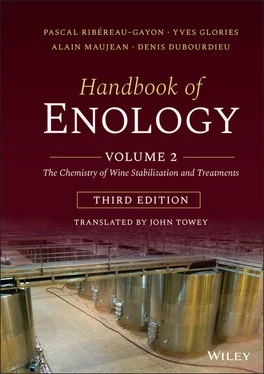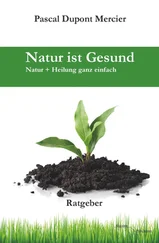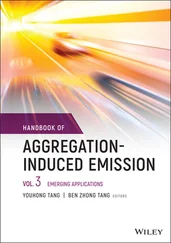5 Chapter 5TABLE 5.1 Amino Acids in Grapes and WineTABLE 5.2 Survey of Ripening in Champagne Grape Varieties in 1986 (Amino Acid...TABLE 5.3 Correlation Between the Logarithm of the Proline Concentration and ...TABLE 5.4 Impact of Nitrogen Addition to Grapevines on the Glutathione Conten...TABLE 5.5 The Various Biogenic Amines and the Corresponding Amino AcidsTABLE 5.6 Analysis of a Sauvignon Blanc Wine by Capillary Electrophoresis (CE...TABLE 5.7 Turbidity Levels (NTU) After Different Protein Stability Tests Carr...TABLE 5.8 Doses of Bentonite (g/hl) Required for the Protein Stabilization of...
6 Chapter 6TABLE 6.1 Calculated Percentages of Different Anthocyanin Forms in the Mixtur...TABLE 6.2 Comparison of the Percentage of Color at 520 nm, Between pH 3 and 4...TABLE 6.3 Calculated Percentage Coloring of Anthocyanin Solutions According t...TABLE 6.4 Influence of Heating Time, in a Water Bath at 100°C, on the Color I...TABLE 6.5 Influence of Storage Time at Room Temperature in the Presence of Ox...TABLE 6.6 Copigmentation of Anthocyanins (A) by Tannins in a Dilute Alcohol M...TABLE 6.7 Influence of the SO 2Content of an Anthocyanin Solution at pH 3.2 o...TABLE 6.8 Comparison of Evolutions in the Results of Tannin Assays in Wine Ag...TABLE 6.9 Influence of the Structure of Different Groups of Phenolic Compound...TABLE 6.10 Effect of Terroir (Soil and Microclimate) on the Reactivity to Pro...TABLE 6.11 Concentrations of Different Dimeric Procyanidins, Trimer C 1, (−)‐M...TABLE 6.12 Development of Anthocyanins and Tannins from Skins and Seeds at Th...TABLE 6.13 Development of Values Characteristic of the Structure of the Tanni...TABLE 6.14 Variations of the Mean Degree of Polymerization (mDP), the Percent...TABLE 6.15 Variations in the Anthocyanin Extraction Coefficient in Wine (α) A...TABLE 6.16 Effect of the Harvest Date on the Anthocyanin Extraction Coefficie...TABLE 6.17 Evolution of the Phenolic Maturity of Cabernet Sauvignon Grapes fr...TABLE 6.18 Influence of the Type of Winemaking Methods on Changes in the Phen...TABLE 6.19 Influence of the Origin of a Wine on Its Phenol Content (Concentra...
7 Chapter 7TABLE 7.1 Characteristics of the Main Monoterpenes and Examples of Concentrat...TABLE 7.2 Example of the Distribution of Free and Bound Forms of the Main Mon...TABLE 7.3 Locations of the Free and Bound Terpene Alcohols in Grapes (Günata,...TABLE 7.4 Characteristics of C13‐Norisoprenoid Derivatives Involved in Wine A...TABLE 7.5 Descriptions and Olfactory Detection Thresholds of the Main Methoxy...TABLE 7.6 Volatile Thiol Composition (ng/l) of Wines from Several Grape Varie...TABLE 7.7 Organoleptic Impact of Volatile Thiols Identified in Sauvignon Blan...TABLE 7.8 Assay of Volatile Thiols (ng/l) in Sauvignon Blanc Wines from the S...TABLE 7.9 Characteristics of Very Aromatic Thiols, Formed During Bottle AgingTABLE 7.10 Examples of Furaneol and Homofuraneol Concentrations (μg/l) in Win...TABLE 7.11 Quantification of Furaneol and Homofuraneol in Musts and Wines Res...TABLE 7.12 Lactones Identified in Wines
8 Chapter 8TABLE 8.1 Analytical Report on Simultaneous Lactic Fermentation of Tartaric A...TABLE 8.2 Ethylphenol and Vinylphenol Contents of Different Wines (Micro gram...TABLE 8.3 Impact of Clarifying Must with Commercial Pectinases on the Vinylph...TABLE 8.4 Ethylphenol Content in Ten Vintages of Various Bordeaux Wines (Cha ...TABLE 8.5 Impact of Polyphenols on the Synthesis of Volatile Phenols by S. ce...TABLE 8.6 Comparative Study of the Synthesis of Volatile Phenols by Lactic Ac...TABLE 8.7 Laboratory Experiment Observing Changes in the Ethylphenol Content ...TABLE 8.8 Impact of Free SO 2Content When Wine Is Put into the Barrel on the ...TABLE 8.9 Influence of a Delay in the Third Racking on the Ethylphenol Conten...TABLE 8.10 Influence of Aging Conditions and Sulfiting Method (Burning Sulfur...TABLE 8.11 Perception Thresholds in Dry White Wine of the Main Compounds Invo...TABLE 8.12 Assay of Chlorophenols and Chloroanisoles in Wines That Have Never...TABLE 8.13 Demonstration of the Dual Contamination of a Red Wine by the Atmos...TABLE 8.14 “Light” Sulfur Compounds Responsible for Reduction OdorsTABLE 8.15 “Heavy” Sulfur Compounds Responsible for Reduction OdorsTABLE 8.16 Impact of Barrel Aging Conditions on the Concentration of Volatile...TABLE 8.17 Impact of Aging Conditions (Six Months) on Sotolon and 2‐Aminoacet...TABLE 8.18 Example of Sotolon, Methional, and Phenylacetaldehdye Concentratio...TABLE 8.19 Glutathione Content (Milligram per Liter) of Sauvignon Blanc Wines...TABLE 8.20 Yellow Color Measurements as Well as 3‐Sulfanylhexanol (3‐SH) and ...TABLE 8.21 Examples of 3‐Methyl‐2,4‐Nonanedione (MND) Contents Found in Some ...TABLE 8.22 Olfactory Characteristics of Volatile Compounds Identified in Grap...TABLE 8.23 Geosmin Content of Red and White Wines from Several Wine‐Growing R...TABLE 8.24 Distribution of Isolates of B. cinerea and Several Species of Peni...TABLE 8.25 Examples of Complexes of B. cinerea and Penicillium Species in Clu...
9 Chapter 9TABLE 9.1 Classification of Dispersed Systems
10 Chapter 10TABLE 10.1 The Main Treatments Available for Clarifying and Stabilizing WinesTABLE 10.2 Surface Charge Densities (d) of Particles from Several Samples of ...TABLE 10.3 Surface Charge Densities (d) at pH 3.5 of Phenolic Fractions Extra...TABLE 10.4 Influence of the Quantity and Type of Gelatin on the Elimination o...TABLE 10.5 Phenolic Composition of Some Commercial Enological TanninsTABLE 10.6 Summary of Products Used to Clarify WineTABLE 10.7 Influence of the Type of Fixed Ions on the Specific Swelling Volum...TABLE 10.8 Quantities of Silica Sol, Gelatin, and Isinglass Appropriate for D...TABLE 10.9 Effect of Various Treatments on the Phenol Content of a White Wine...
11 Chapter 11TABLE 11.1 Correspondence Between Turbidity Measurements (NTU) and AppearanceTABLE 11.2 Characteristics of a White Wine After Filtration on Three Diatomac...TABLE 11.3 Precoat Filtration: Quantity and Quality of Filter Aids Required t...TABLE 11.4 Filter Aids in a Plate‐and‐Frame Filter (Paetzold, 1993)TABLE 11.5 Flow Rates and Filter Aid Consumption for Various Rotary Vacuum Fi...TABLE 11.6 Contamination of a Sweet White Wine During Storage, After Diatomac...TABLE 11.7 Successive Stages in the Clarification of a Sweet White Wine Until...TABLE 11.8 Filtration Trial to Find the Best Type of Filter Pad for Clarifyin...TABLE 11.9 Impact of Filter Sterilization on Filtration Quality (Serrano, 198...TABLE 11.10 Characteristics of Pall Membranes (Gautier, 1984)TABLE 11.11 Filtering a Red Wine on Prefilter Cartridge and Membrane (Serrano...TABLE 11.12 Application of Various Filtration Techniques to a White Wine Afte...TABLE 11.13 Effects of Different Types of Filtration on the Chemical Composit...TABLE 11.14 Effects of Different Types of Filtration on the Chemical Composit...
12 Chapter 12TABLE 12.1 Characteristics of Wine Treated with Hydrogen and Sodium Cation Ex...TABLE 12.2 Comparison of Different Ion Exchange Regeneration Methods (Ribérea...TABLE 12.3 Changes in Analysis Parameters of a Red Wine According to the Rate...
13 Chapter 13TABLE 13.1 Effect of Oxygen Content on the Oxidation–Reduction Potential of a...TABLE 13.2 Influence of Iron (8 mg/l of Fe II) and Copper (2 mg/l of Cu) on th...TABLE 13.3 Influence of the Main Components of Wine on the Oxygen Consumption...TABLE 13.4 Influence of the Container on the Oxidation–Reduction Status of a ...TABLE 13.5 Estimated Quantities of Oxygen Absorbed During Maceration (Results...TABLE 13.6 Overall Estimate of the Quantities of Oxygen Dissolved via Aeratio...TABLE 13.7 Quantity of Oxygen Likely to be Added by Microbubbling During the ...TABLE 13.8 Color Changes in Red Wine Depending on Aeration Conditions (Ribére...TABLE 13.9 Different Forms of Anthocyanins as a Function of Aging Conditions ...TABLE 13.10 Changes in the Phenol Content of a Madiran Wine After Five Months...TABLE 13.11 Changes in the Phenol Composition of a Red Wine (Merlot) After Si...TABLE 13.12 Effect of Aeration and Temperature on Changes in the Color of Mer...TABLE 13.13 Evolution of the 3–Sulfanylhexanol Concentration After Alcoholic ...TABLE 13.14 Evolution of 3‐Sulfanylhexanol Concentrations (3‐SH) During Barre...TABLE 13.15 Incidence of the Dissolved Oxygen Assay and the Presence of Lees ...TABLE 13.16 Evolution of 3‐Sulfanylhexanol Concentrations (3‐SH) According to...TABLE 13.17 Evolution of 3‐Sulfanylhexanol Concentration and Dissolved O 2Con...TABLE 13.18 Free Sulfur Dioxide Concentration in Various Red Wines and the Ev...TABLE 13.19 Changes in the Phenol Content of a Bordeaux Wine (1998) Stored fo...TABLE 13.20 Oxygen Dissolved During Various Operations Involved in the Aging ...TABLE 13.21 Measuring the Porosity Characteristics of Oak Samples (Porosity E...TABLE 13.22 Influence of Geographical Origin on the Composition of French Oak...TABLE 13.23 Variations in Volatile and Fixed Compounds According to the Botan...TABLE 13.24 Impact of Accelerated Artificial Seasoning on the Aroma and Polyp...TABLE 13.25 Impact of Toasting Intensity on the Polyphenols Extractable from ...TABLE 13.26 Impact of Toasting Intensity on the Formation of Furan Aldehydes aTABLE 13.27 Impact of Toasting on the Formation of Volatile Phenols a(Chatonn...TABLE 13.28 Impact of Toasting Intensity on the Formation of Phenol AldehydesTABLE 13.29 Impact of Toasting Intensity on the Formation of β ‐Methyl‐ γ ...TABLE 13.30 Volatile Compounds Extracted from Oak in Different Forms aby Two ...TABLE 13.31 Acetic Acid, Ethyl Acetate, and Ethylphenol Contents of a Red Win...
Читать дальше












